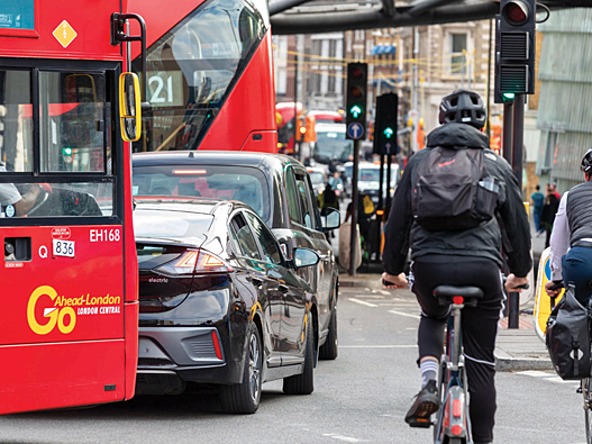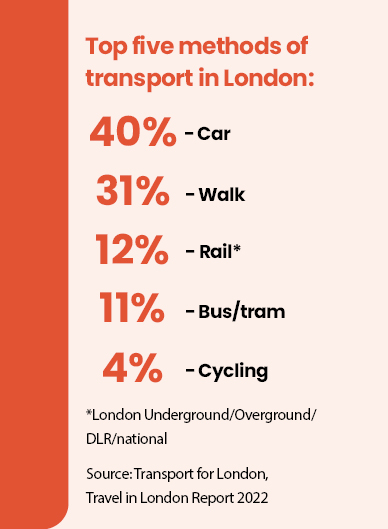Mapping a new route: Encouraging greener London transport

Transport in London has been big news over the past year. The expansion of the ultra-low emission zone to cover the city’s outer boroughs has become a political football, and the mayor, Sadiq Khan, wants 80% of all journeys to be made by active or sustainable travel by 2041, requiring a 50% cut in car journeys every day.
Think tank Centre for London undertook research to examine the city’s transport policies and explore whether changing the cost of transport might encourage people to switch from using their cars. “London, like every city in the world, is facing a climate crisis,” says Millie Mitchell, senior researcher at Centre for London and co-author of the ‘Moving with the times’ report. “Transport is one of the largest-emitting sectors – it accounts for a quarter of greenhouse gas emissions in London and, of that quarter, 75% is road transport.”
In addition to qualitative interviews with policymakers at different levels of government, the researchers carried out financial modelling, and modelled the impact of possible policies on nine typical individual and family personas, based on the Transport for London (TfL) classification of Londoners. The research also modelled the costs associated with a specific journey – such as trips to visit family or commuting.
To understand the costs for each persona, quantitative analysis was used to identify their most likely borough of residence, age, children, income, and the price of their cars.
 Among the recommendations from the research was that the government and TfL should help people to know the cost of driving relative to other modes of transport, such as car clubs, trains, cycling and buses, and help residents find out about financial incentives of not owning a car.
Among the recommendations from the research was that the government and TfL should help people to know the cost of driving relative to other modes of transport, such as car clubs, trains, cycling and buses, and help residents find out about financial incentives of not owning a car.
The researchers also recommended emission- and distance-based road user charging – a hypothetical policy that would put in place a minimum charge, equivalent to at least a single bus fare, to keep driving more expensive than public transport. This policy is similar to the Ulez – whereby cars are taxed for not meeting emissions standards – but looks, instead, to tax those who are the heaviest road users or causing the most emissions.
“It is important that we don’t consider that a financial policy will impact everyone in the same way,” Mitchell explains, “but look at who are the winners and losers, and whether that is a fair and equitable outcome, as well as providing a sustainable outcome.”
Infrastructure is key when discussing public transport and cycling, and researchers explored this in the modelled journeys analysis. “We can financially incentivise and make it easier for people to access alternative transport, and we absolutely should be doing that to make it fair and accessible. But if the infrastructure is not in place, you probably won’t do it, even if it is more financially viable,” says Mitchell.
Most importantly, she adds, politicians should not simply use the ‘carrot’ or the ‘stick’ approach when designing policy, and instead look to have a good mix of effective ideas that work in tandem to bring about a more sustainable transport environment.
Framing is key, given the car’s position in society as a status symbol. Communication can also help people to understand the true cost of driving, which is often the most expensive transport option available. However, many people find it difficult to compare driving costs with public transport fares because of the differences in fuel consumption between vehicles.
Mitchell says: “Car ownership is very ideological – some people will see themselves as a car person or a bike person. It is important how we frame policies so people buy into them and don’t see them as an attack on themselves.”
As London continues working towards a more sustainable future and that 2041 transport target, these ideas will be to the fore. The question is whether they can take root among the public and policymakers.

We hope you enjoyed this article.
Research Live is published by MRS.
The Market Research Society (MRS) exists to promote and protect the research sector, showcasing how research delivers impact for businesses and government.
Members of MRS enjoy many benefits including tailoured policy guidance, discounts on training and conferences, and access to member-only content.
For example, there's an archive of winning case studies from over a decade of MRS Awards.
Find out more about the benefits of joining MRS here.












0 Comments